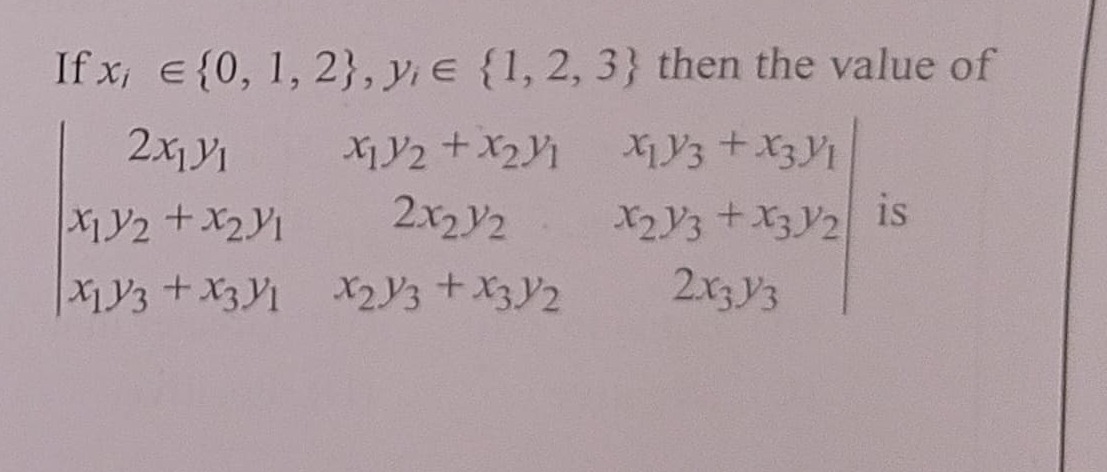Question
Question: If $x_i \in \{0, 1, 2\}, y_i \in \{1, 2, 3\}$ then the value of $\begin{vmatrix} 2x_1y_1 & x_1y_2 +...
If xi∈{0,1,2},yi∈{1,2,3} then the value of
2x1y1x1y2+x2y1x1y3+x3y1x1y2+x2y12x2y2x2y3+x3y2x1y3+x3y1x2y3+x3y22x3y3 is

0
Solution
Let the given determinant be D. The elements of the determinant are Mij. Let x=x1x2x3 and y=y1y2y3.
Consider the outer product of these two vectors: A=xyT=x1x2x3(y1y2y3)=x1y1x2y1x3y1x1y2x2y2x3y2x1y3x2y3x3y3.
The transpose of A is: AT=(xyT)T=(yT)TxT=yxT=y1y2y3(x1x2x3)=y1x1y2x1y3x1y1x2y2x2y3x2y1x3y2x3y3x3.
Now, let's form the sum A+AT: A+AT=x1y1x2y1x3y1x1y2x2y2x3y2x1y3x2y3x3y3+y1x1y2x1y3x1y1x2y2x2y3x2y1x3y2x3y3x3
A+AT=x1y1+y1x1x2y1+y2x1x3y1+y3x1x1y2+y1x2x2y2+y2x2x3y2+y3x2x1y3+y1x3x2y3+y2x3x3y3+y3x3
A+AT=2x1y1x1y2+x2y1x1y3+x3y1x1y2+x2y12x2y2x2y3+x3y2x1y3+x3y1x2y3+x3y22x3y3.
This is exactly the matrix given in the problem. So, the problem asks for det(A+AT), where A=xyT.
The rank of an outer product of two non-zero vectors is 1. Given xi∈{0,1,2} and yi∈{1,2,3}. Since yi∈{1,2,3}, none of the yi can be zero, so y=0. If x=0 (i.e., x1=x2=x3=0), then A=0 and AT=0, so A+AT=0. The determinant of the zero matrix is 0. If x=0, then rank(A)=rank(xyT)=1. Similarly, rank(AT)=rank(yxT)=1.
We know that for any two matrices P and Q, rank(P+Q)≤rank(P)+rank(Q). Therefore, rank(A+AT)≤rank(A)+rank(AT)=1+1=2. So, the rank of the matrix A+AT is at most 2.
The given matrix is a 3×3 matrix. If the rank of a n×n matrix is less than n, then its determinant is 0. Here, n=3 and rank(A+AT)≤2, which is less than 3. Thus, the determinant of the given matrix is 0.
